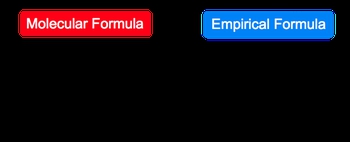The distinction between empirical and molecular formulas is fundamental in understanding chemical compounds. The empirical formula represents the simplest whole number ratio of the elements in a compound, derived from the mass percentages of its constituent elements using the mole concept. This concept facilitates conversions between grams, moles, and units such as molecules, ions, or atoms.
To illustrate, consider the molecular formula C3H6O3. The numbers 3, 6, and 3 can all be divided by 3, leading to the empirical formula CH2O, which is the reduced form. Similarly, for the molecular formula C10H14N2, dividing each subscript by 2 yields the empirical formula C5H7N. In contrast, the molecular formula C12H22O11 does not allow for simplification, resulting in the same empirical and molecular formulas.
In summary, the molecular formula provides the actual number of each type of atom in a compound, while the empirical formula offers a simplified representation. Understanding this difference is crucial for accurately interpreting chemical compositions and reactions.


